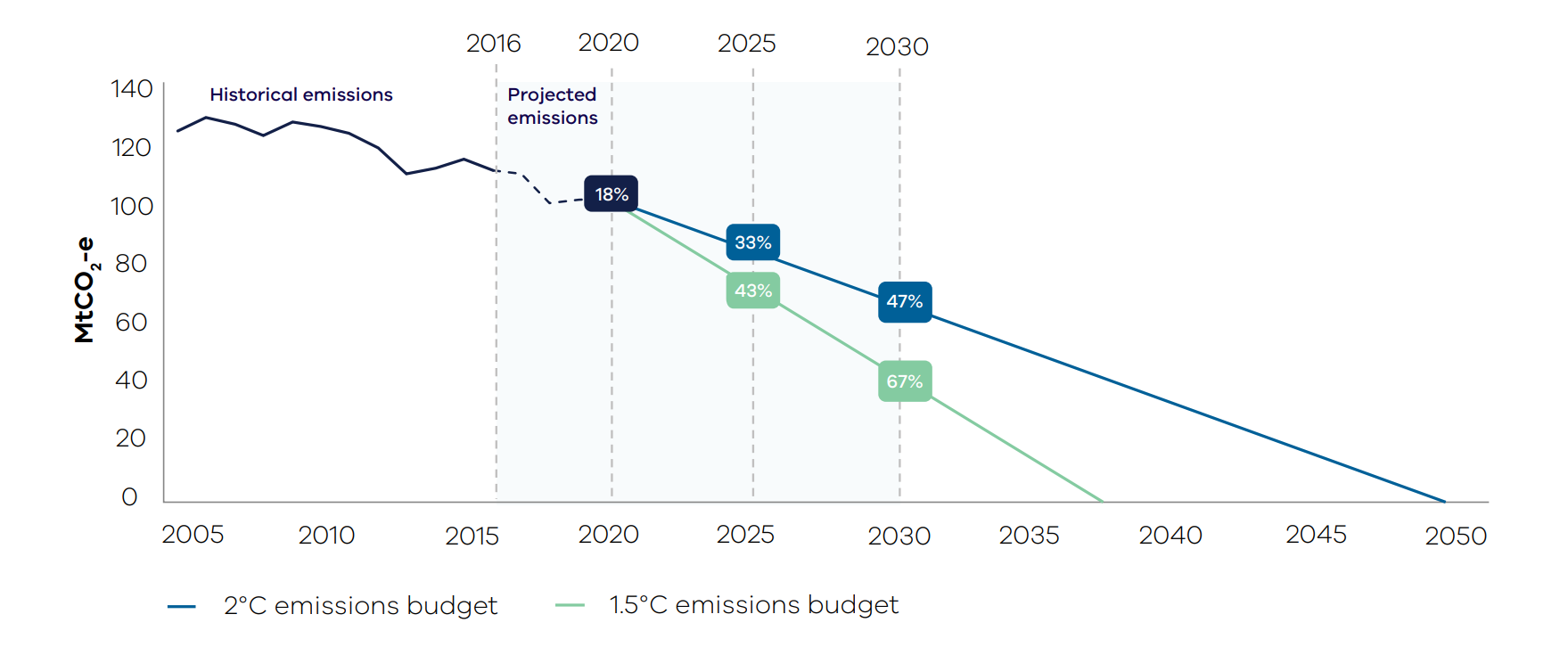The Andrews government appointed a panel of experts headed by former federal climate and energy minister Greg Combet to advise them on the targets.
The Combet panel looked at three scenarios for cutting greenhouse gas emissions, 1.5 degrees, “well below 2”, and 2 degrees.
This was calculated using ‘carbon budgets’. A carbon budget is a limit set on the total emissions allowable to achieve different temperature goals.
Combet’s recommendations
The Combet panel recommended a 2025 target range of 32- 39% reductions, and a 2030 target of 45-60% below 2005 levels (2005 is the year the government is using as its baseline).
As the blue line in the graph below shows, the weakest targets in Combet’s recommended range puts us on track for 2 degrees of warming.
Scientists say at 2 degrees we: lock in death of the Great Barrier Reef, the melting of Greenland ice sheets, on track for 8 metres of sea level rise, and face days with unprecedented temperatures of 50 degrees Celsius in Melbourne.

Combet Report, Figure ES1, p13
So how could we keep warming below 1.5 degrees? The graph below shows how quickly we’d have to cut emissions after 2030 if we follow Combet’s recommended range of targets.

Combet Report, Figure 5.5, p57
If we hit 60% in 2030, we’ll have 5 years to get to zero emissions.
If we only hit 45% in 2030, we’ll need to stop all remaining emissions immediately because we’ve already blown the carbon budget.
So Combet’s recommended range means limiting warming to 1.5 degrees would be somewhere between extremely hard and basically impossible.
Why did a panel of scientists and policy experts recommend targets not in line with the Paris goal of limiting warming to 1.5 degrees? In their words:
“While climate science clearly demonstrates that a 1.5 degree world would be much safer, with significantly lower impacts than 2 degrees of warming, it represents an ambition that has not fully crystallised yet.”
Using a lack of ambition elsewhere to justify your own lack of ambition is a cop out. And the politics of climate change have shifted since the summer.
In early March bushfire survivors added a late submission to the Combet report, urging the government to take into account the climate impacts we’re already suffering when setting climate targets.
So what does a real 1.5 degree target look like?
The graph below shows target recommendations for 1.5 degrees (green) vs 2 degrees (blue) of warming.

Combet Report, Figure 5.2, p53
According to this, a 1.5 degree target requires emissions cuts of 43% by 2025 and 67% by 2030.
But there’s a catch – the carbon budgets considered for scenarios consistent with 1.5 degrees only give us a 50-50 chance of staying under that goal. They don’t guarantee it. Plus, it also assumes enormous amounts of negative emissions after 2050 – ie. sucking CO2 out of the atmosphere – using technology that does not yet exist. And even 1.5 degrees of warming is dangerous.
So we should consider these numbers an absolute minimum.
According to this modelling we need to have targets of 67% by 2030 to have a moderate chance of reaching 1.5 degrees. Which means targets should be at least 67%.
A safer target would be 80-100% by 2030.
Conclusions
45% by 2030 is a dud target because it forgoes any chance of keeping warming to 1.5 – remembering that even 1.5 degrees of warming is going to have severe consequences.
Even 60% barely gives us any chance of sticking to 1.5 degrees.
67% gives us a fighting chance but the deeper our cuts in the next decade, the better our chances.
Premier Daniel Andrews knows all of this. He has said he wants Victoria to be a leader on climate change. Three times his government has endorsed the objective of the Paris Agreement of aiming to limit warming to 1.5 degrees.
He has talked the talk. The question now is whether he will walk the walk by committing to targets upwards of 67% by 2030.




